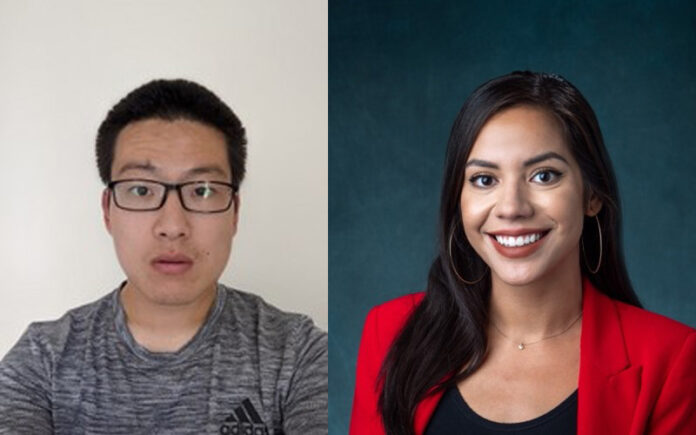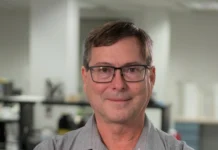Dr. Xiance Wang is an R&D materials scientist/chemist at Align Technology in San Jose, California, focusing on developing photopolymer-based additive manufacturing of new orthodontic products. He received his Bachelor’s in Chemical Biology from Xiamen University, China, and a Ph.D. in Chemistry from University of Colorado-Boulder. Dr. Camila Uzcategui is cofounder and CEO of Vitro3D, a company with a mission to increase health care access with a paradigm-shifting volumetric 3D printer. Her Ph.D. and postdoctoral research focused on building light-based 3D printers and innovating 3D-printing materials and processes for life science applications.
RTYP: When did you first learn about UV/EB as an industry and technology? Where/how did you learn the UV/EB technology?
XW: That was after I joined Prof. Bowman’s group, which has been focusing on developing new photopolymer materials taking advantage of “Click” reactions as well as dynamic covalent chemistries, for my graduate study at University of Colorado-Boulder.
My graduate course on polymers covered the photopolymerization basics, as you would expect. And I learned the UV/EB technology during my graduate research of high-performance photopolymers based on “Click” chemistries for potential dental and 3D-printing applications.
CU: I think the first time I learned about UV/EB technology was in my organic chemistry class in undergrad; however, I didn’t really think of it as an industry until graduate school. In graduate school, I was exposed to different UV/EB technologies and applications in classes, in my research and through conferences such as RadTech and Photopolymerization Fundamentals.
As a materials science and engineering Ph.D. student, I took several UV/EB-related classes that ranged from polymer chemistry to optics. In addition to classes, I learned some of my most relevant knowledge at conferences related to UV/EB technology.
RTYP: Have you run into any challenges as a young professional?
XW: As a young professional and young parent, I found it a challenge to balance work and family, but luckily my boss is very supportive and always telling me that “family is most important to you.”
CU: I think the biggest challenge I ran into in UV/EB as a young professional was feeling like I didn’t have a community in the UV/EB space because of how broad the industry is. Furthermore, as graduate students, we often were siloed in our specific applications, and it was hard to expand our network to the broad UV/EB space.
RTYP: How do you think we could encourage more young professionals to get involved in UV/EB technology?
XW: We could target STEM students generally because UV/EB technology is far-reaching, especially with the rapid growth of photopolymer 3D printing. And students with diverse backgrounds (chemistry, materials science, engineering, software and so on) can both learn and contribute to the UV/EB technology.
CU: We could encourage more young professionals to get involved in UV/EB technology by making them aware of the diverse and impactful applications that are using UV/EB technologies earlier in their career and lives. Furthermore, I think creating more community in the industry is pivotal to encouraging involvement since it allows for young professionals to expand their network and knowledge in the field.
RTYP: What would your suggestions be for students or YPs who are just starting their professional careers?
XW: Don’t be afraid to make mistakes. You learn from your mistakes, and some people learn from your mistakes, too.
CU: My biggest recommendation would be to find mentors early on in their careers – specifically, a set of diverse mentors who are in different fields and stages of their careers. These mentors can help students understand the field better and help identify how they can be successful as they move forward. My success so far can be partly attributed to the community of researchers, scientists and industry professionals who have supported and guided me throughout my career, and I would encourage students to start building their network as early as possible.
RTYP: Do you have anything else you want to share with us?
CU: As young professionals, it can be difficult to find purpose in the industry and to take up space early in our careers. I would encourage other young professionals to follow their gut and to not be afraid to make mistakes or ask “stupid” questions. Our perspective is not only important, but it is necessary to usher in innovations and disrupt industries. There still are so many interesting problems that can be solved and needs that can be alleviated with the help of UV/EB technology. It is up to us as young professionals to push the boundaries of the current technology and bring in new perspectives to the industry.
The RadTech YP Committee aims to help young professionals (YPs) grow in the use and development of UV & EB technology. It is a group dedicated to enhancing interactions between YPs and senior experts within RadTech. YPs are students and professionals early in their careers who utilize UV & EB technology in industry, government or academia. For questions or to get involved, email yp@radtech.org.







